MRE
MRE - Ministry of Foreign Affairs
The number of visas granted for entry into the country is exhibiting an upward trend, with a significantly higher volume compared to February 2022, and a 11.9% increase compared to January (Graph 1).
Visas issued for tourism purposes accounted for the highest number, followed by visas for work, study, and humanitarian reception (Graph 2).
Among the nationalities, Angolans, Chinese, and Indians were the ones who benefited the most from the visas issued (Map 1).
GRAPH 1
Number of visas issued by consular offices - Brazil, 2021-2023
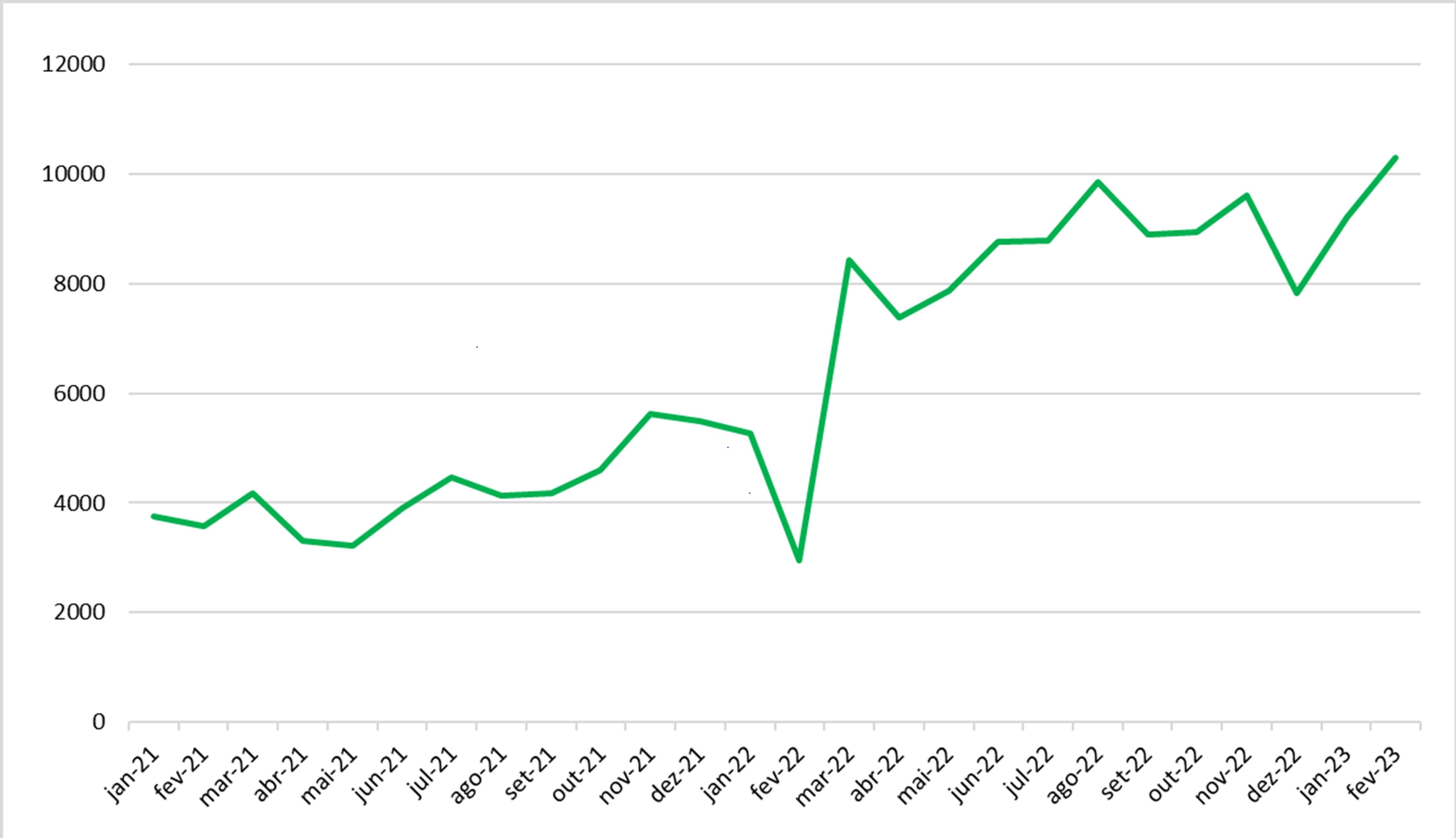
Source: OBMigra (2023), based on data from the Ministry of Foreign Affairs.
GRPH 2
Number of visas granted, according to typologies - Brazil, February 2023.
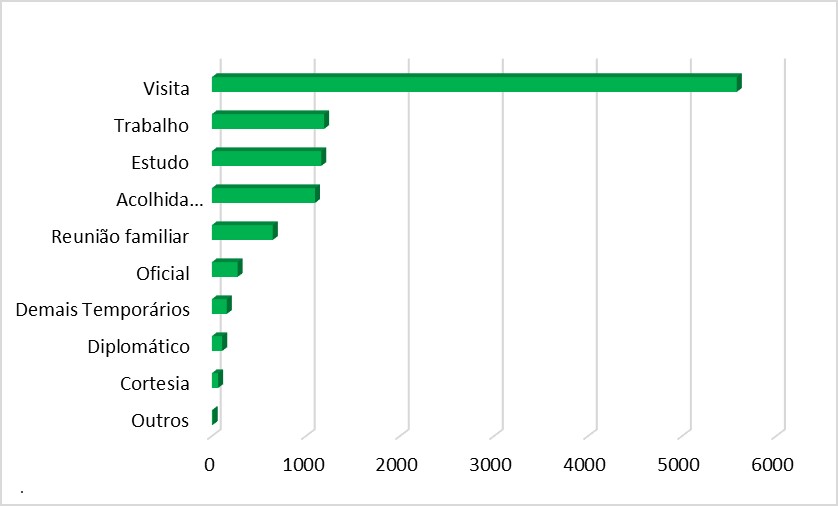
Source: OBMigra (2023), based on data from the Ministry of Foreign Affairs.
MAP 1
Number of visas granted by main nationalities - Brazil, February 2023.
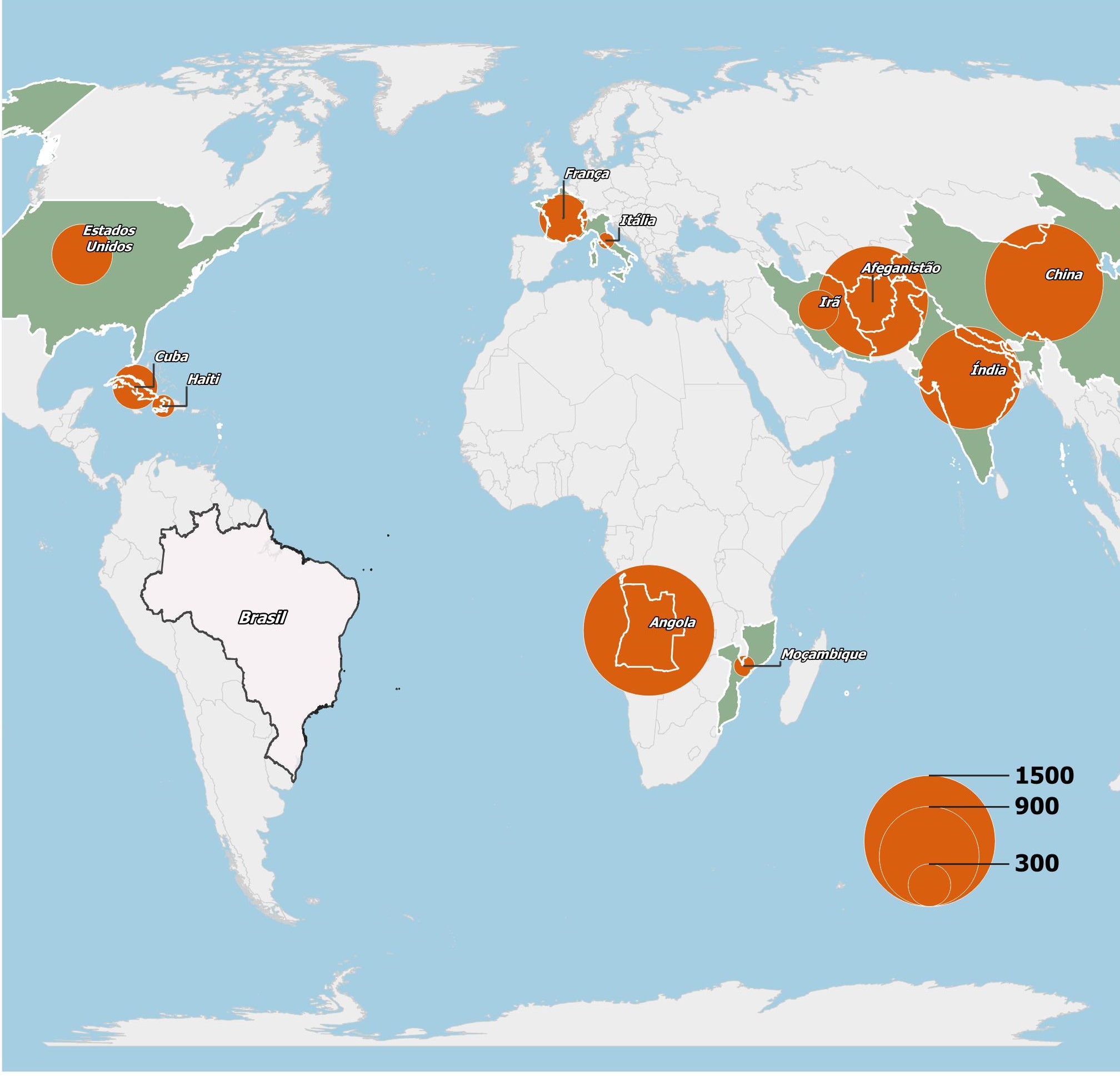
Source: OBMigra (2023), based on data from the Ministry of Foreign Affairs.
STI
STI (International Traffic System)
The number of people entering and leaving Brazilian borders experienced a decline compared to January (-20.0%), but remained significantly higher than the previous twelve months (112.4%), as depicted in Graph 3.
During this period, there were a total of 2.6 million entries and exits, with Argentineans and Chileans being the predominant nationalities crossing our borders (Graph 4).
GRAPH 3
Cross-border movements, by month of registration, Brazil 2019/2023

Source: OBMigra (2023), based on data from the Brazilian Federal Police, International Traffic System (STI).
GRAPH 4
Cross-border movementes, according to main countries - Brazil, February 2023
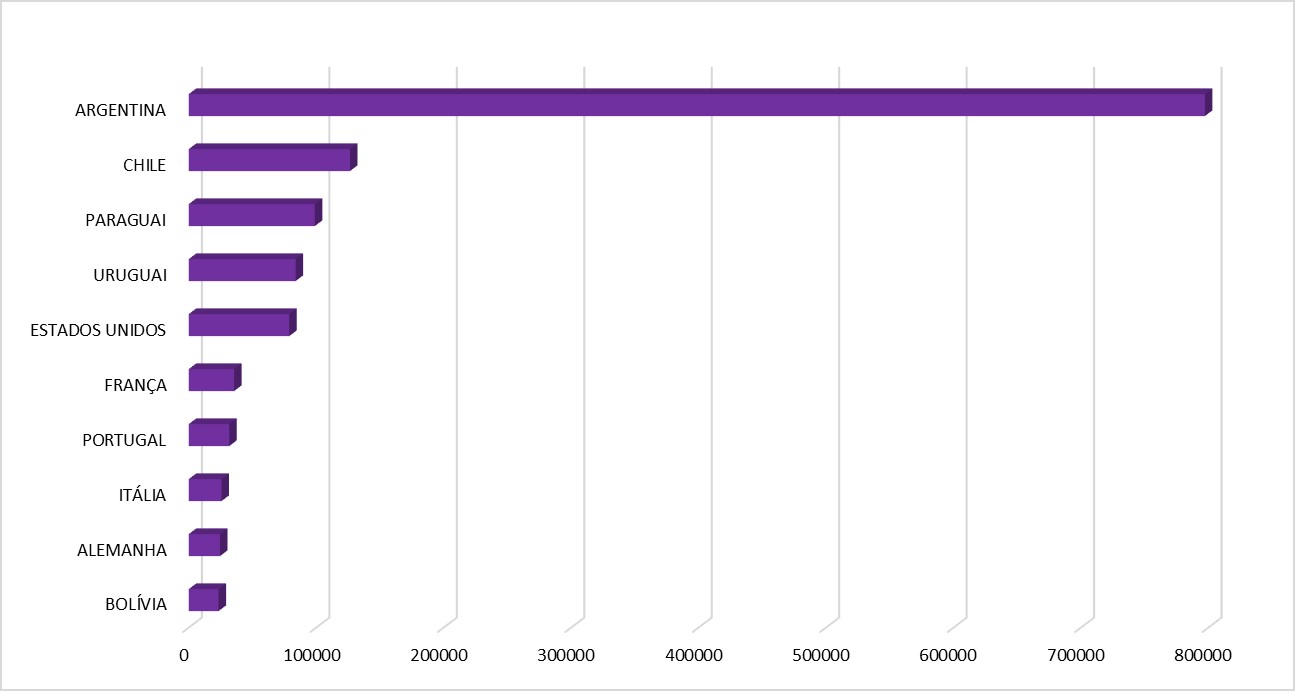
Source: OBMigra (2023), based on data from the Brazilian Federal Police, International Traffic System (STI).
SISMIGRA
SisMigra (National Migration Registry System)
For the second consecutive month, there has been an increase in the volume of residence applications (Graph 5). This positive trend is attributed to the number of temporary registrations, particularly through eligibility criteria 273 (Venezuelans) and 209 (Mercosur Residency Agreement).
The main cities indicated as the place of residence for immigrants were Boa Vista/RR, São Paulo/SP, and Manaus/AM (Graph 6).
Regarding the main nationalities, Venezuelans continued to lead in terms of the number of residence registrations, followed by Bolivians, Colombians, Haitians, and Argentines (Map 2).
GRAPH 5
Number of immigrant registrations, by month of registration - Brazil, 2019/2023

Source: OBMigra (2023), based on data from the Brazilian Federal Police, National Migration Registry System (SISMIGRA).
GRAPH 6
Number of migrant registrations, by main municipalities, Brazil - February 2023
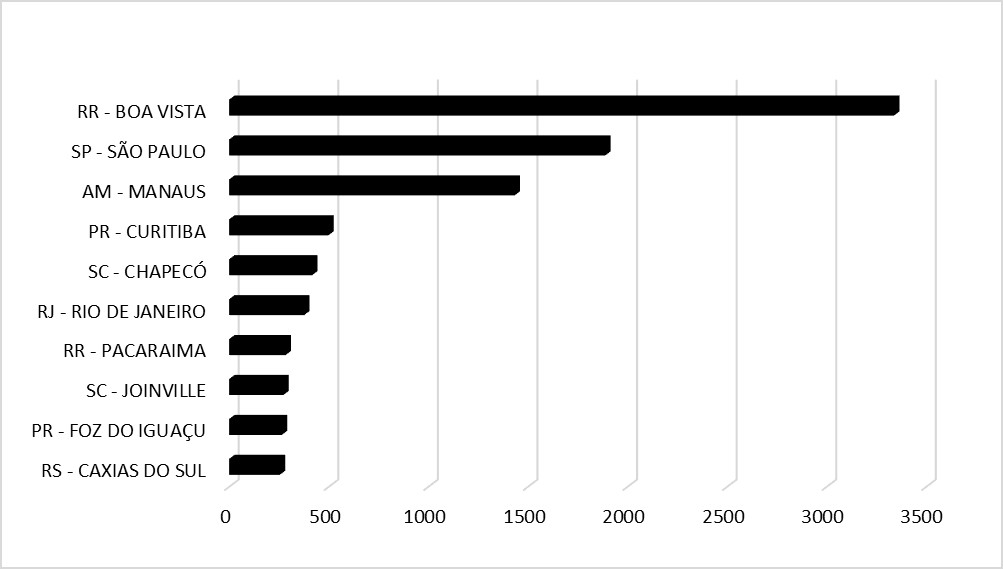
Source: OBMigra (2023), based on data from the Brazilian Federal Police, National Migration Registry System (SISMIGRA).
MAP 2
Number of immigrant registrations, by countries of birth, February 2023.
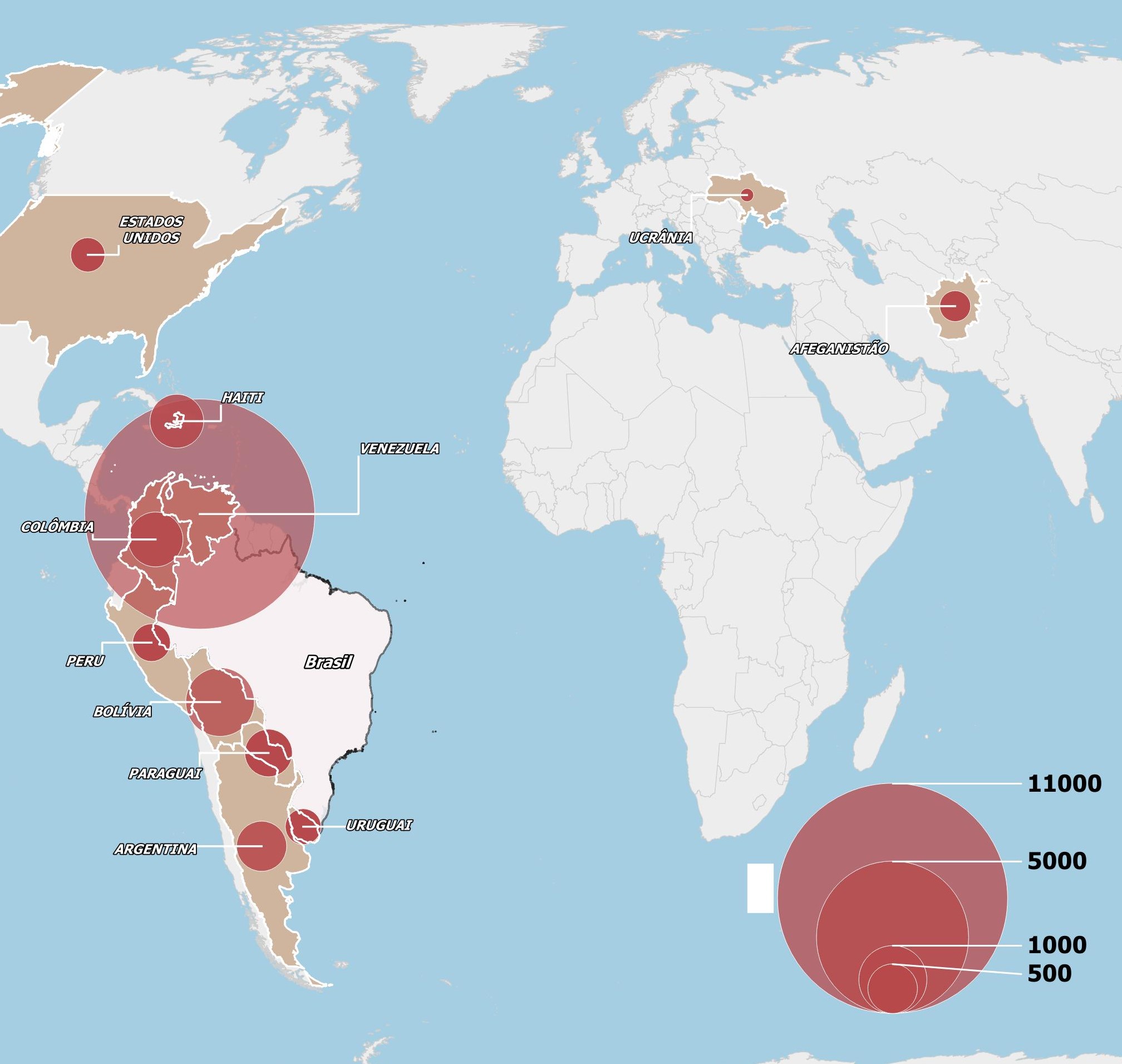
Source: OBMigra (2023), based on data from the Brazilian Federal Police, National Migration Registry System (SISMIGRA).
Solicitantes
Applicants for refugee status recognition
Since December 2022, there has been a consistent increase in the number of applications for refugee status (Graph 7).
The primary age group among applicants was 25 to 39 years old, followed by individuals younger than 15 years old, a segment that has consistently shown significance in recent months and requires specific public policies (Graph 8).
Venezuelans and Cubans emerged as the prominent nationalities among the applicants, with Angolans maintaining their position in third place, while Indians have begun to gain relevance (Map 3).
.
GRAPH 7
Number of applications for recognition of refugee status, by month of registration - Brazil, 2019-2023
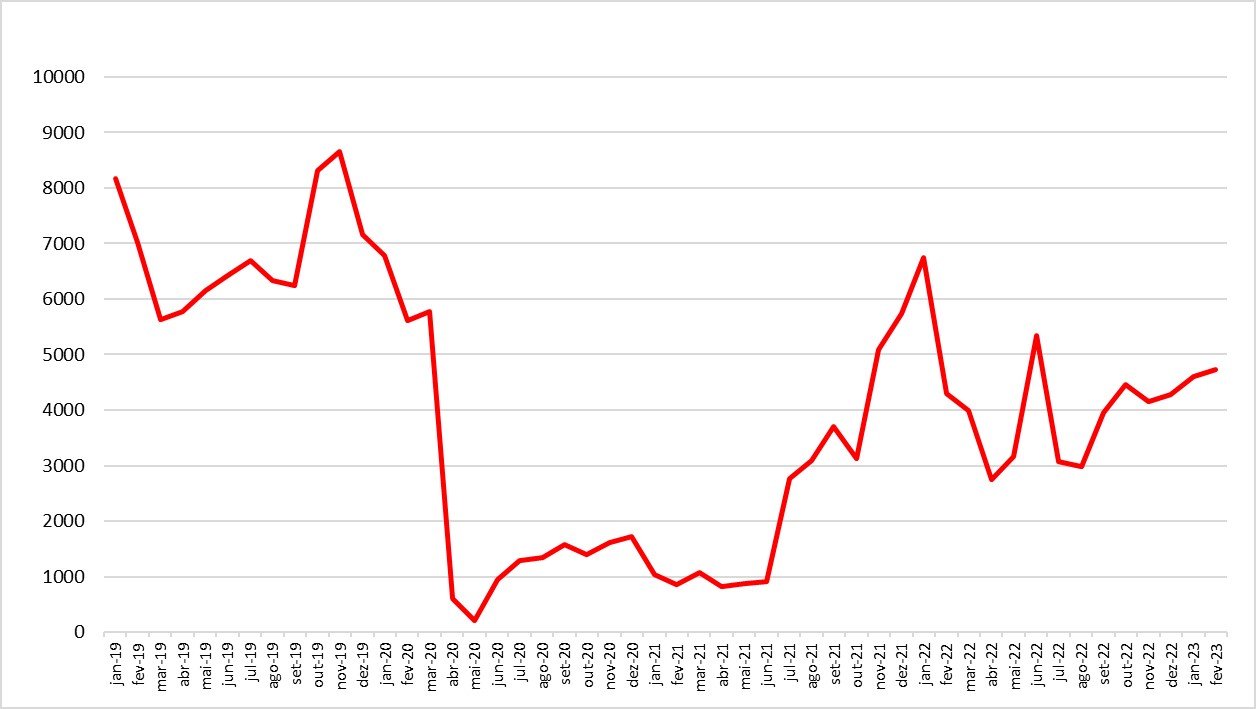
Source: OBMigra (2023), based on data from the Brazilian Federal Police, Asylum Claims, and the System of the National Committee for Refugees (SISCONARE).
GRAPH 8
Number of applications for recognition of refugee status, by month and age groups - Brazil, January and February 2023
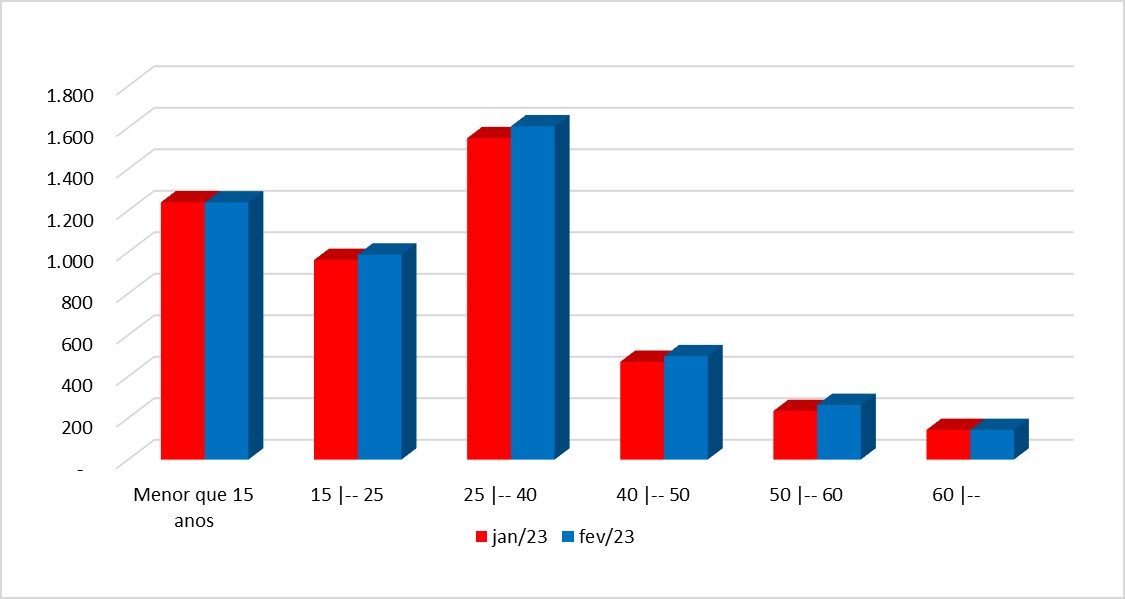
Source: OBMigra (2023), based on data from the Brazilian Federal Police, Asylum Claims.
.
MAP 3
Number of applications for recognition of refugee status, according to main countries, February 2023.
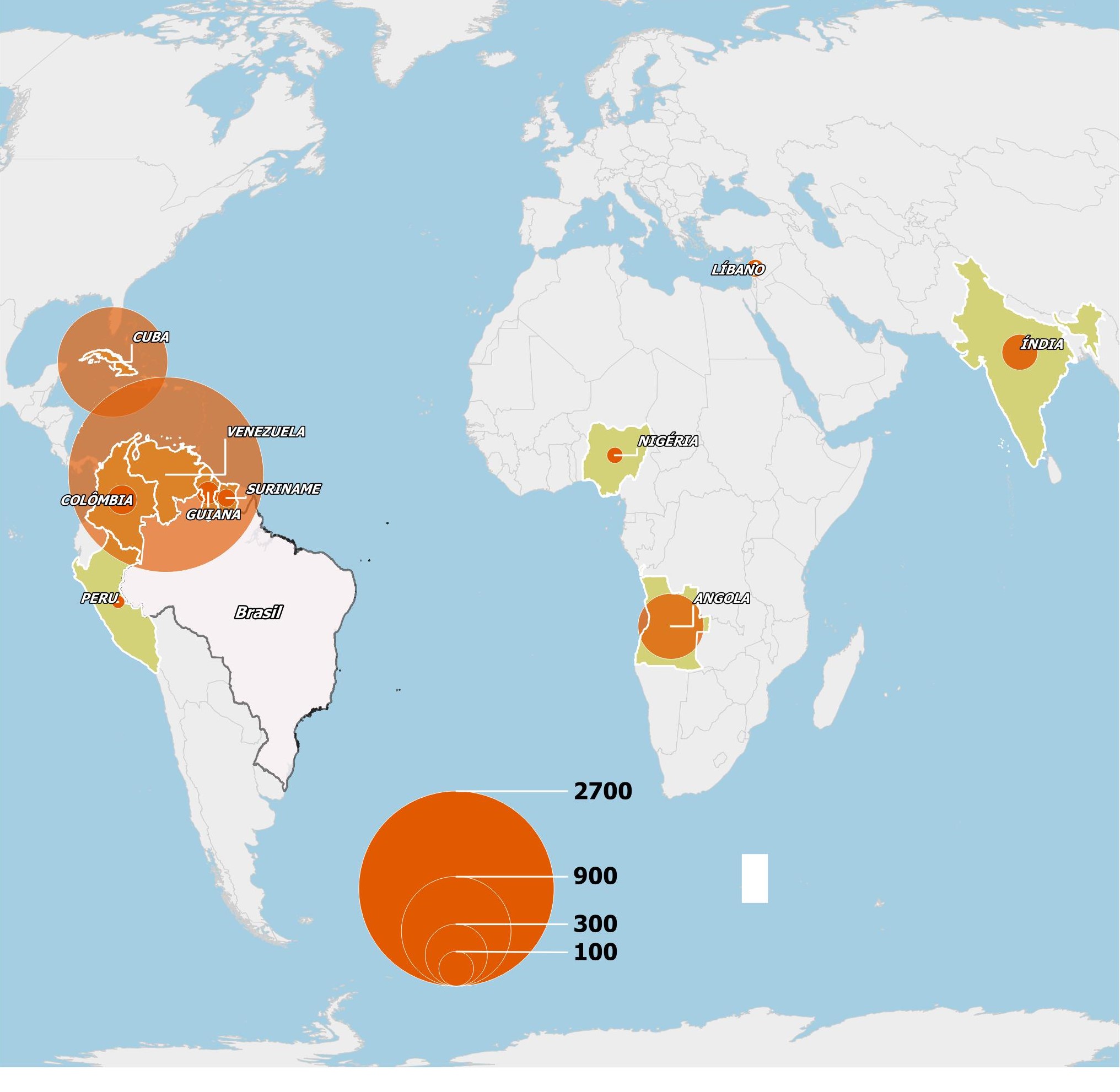
Source: OBMigra (2023), based on data from the Brazilian Federal Police, Asylum Claims.
CGIL
CGIL (General Coordination of Labor Immigration)
After experiencing consecutive declines since October 2022, the volume of residence permits for work and investment purposes exhibited an increase compared to January, returning to the average of 2 thousand permits observed in the past two years (Graph 9).
Among the main nationalities obtaining permits, Chinese and Filipinos stood out (Graph 10).
Furthermore, there has been a recovery in the number of authorizations for skilled workers, with Normative Resolutions RN02 (workers with employment contracts), RN30 (renewal or extension of the authorization), and RN11 (directors/managers) being the most active categories (Graph 11).
GRAPH 9
Number of work permits for labor and investment purposes, by month of registration - Brazil, 2019-2023
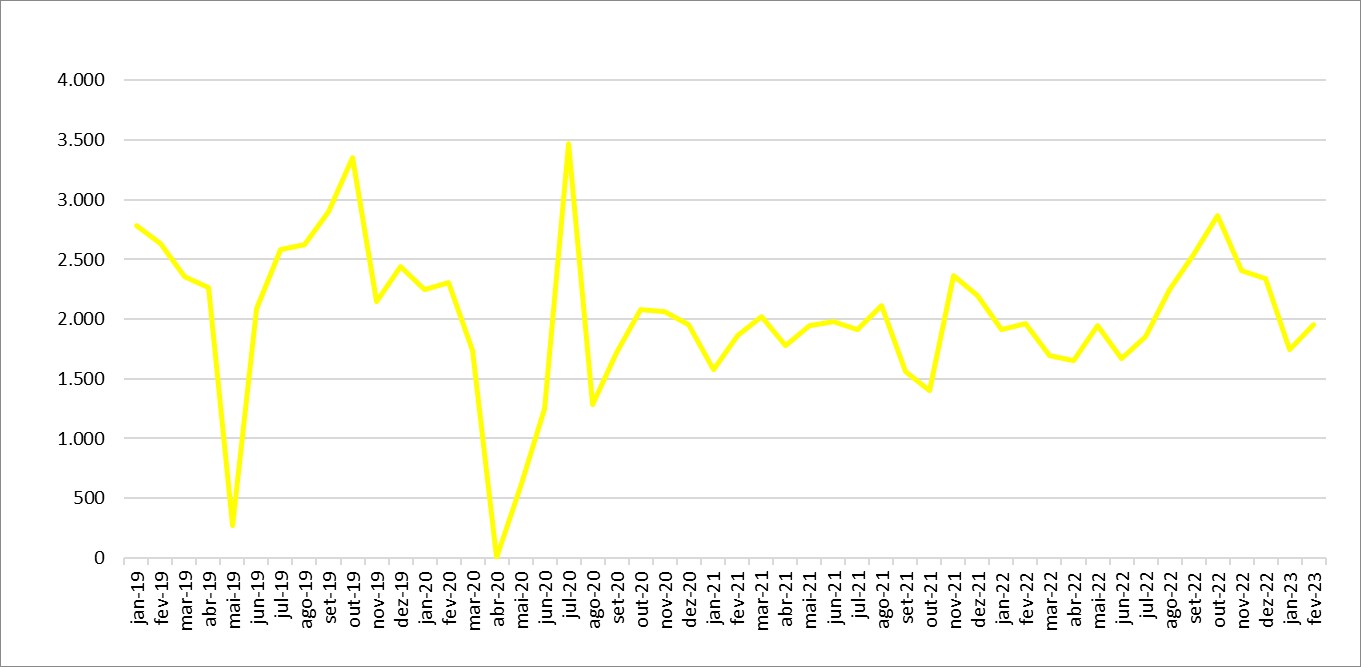
Source: OBMigra (2023), based on data from the General Coordination of Labor Immigration (CGIL).
GRAPH 10
Number of permits granted, by main countries - Brazil, January and February 2023
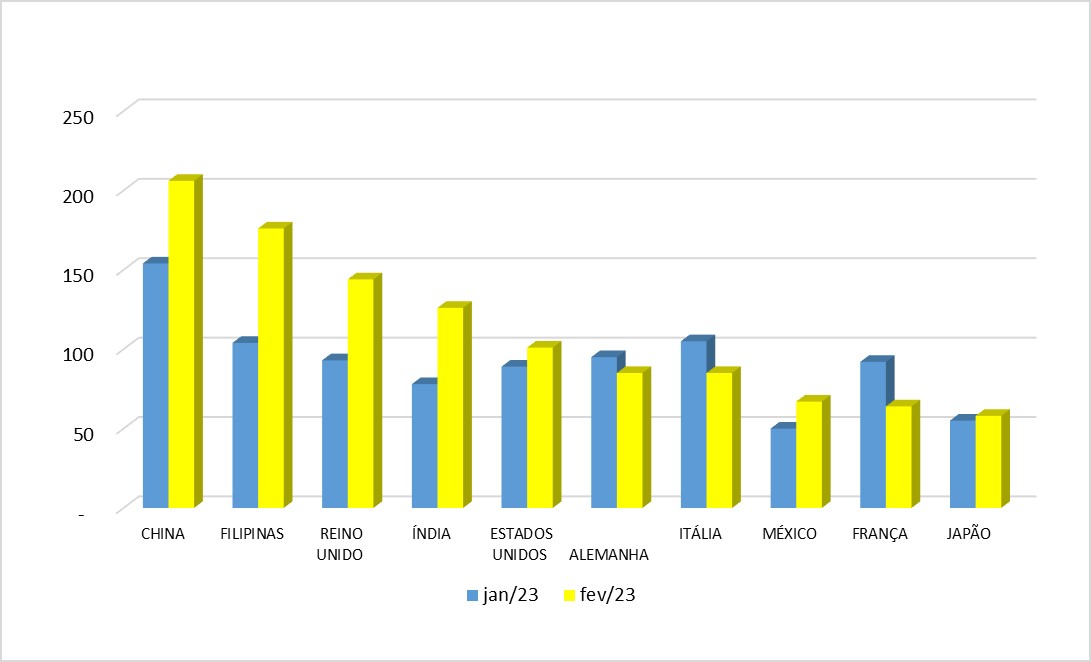
Source: OBMigra (January and February 2023), based on data from the General Coordination of Labor Immigration/Ministry of Justice and Public Security.
GRAPH 11
Number of permits granted to skilled workers, by month, by type of permit - Brazil, January and February 2023.
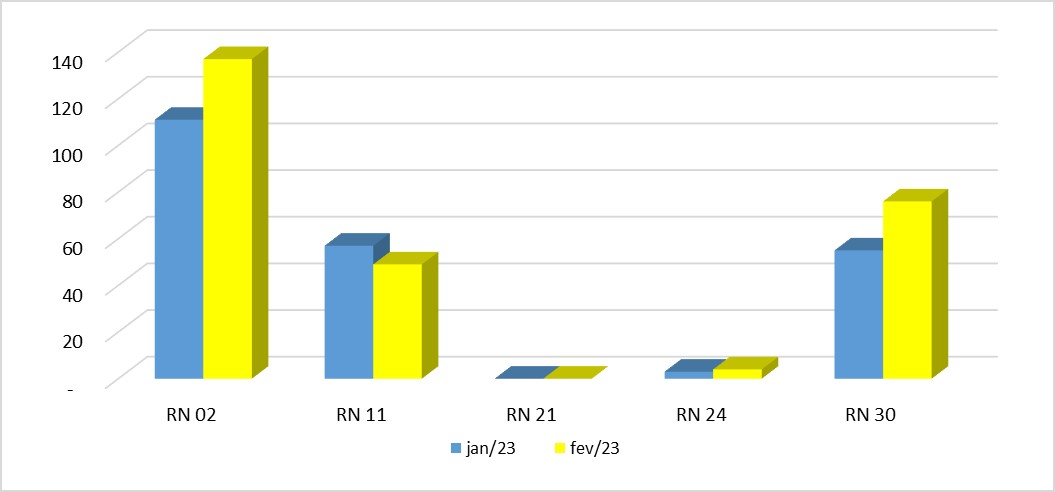
Source: OBMigra (January and February 2023), based on data from the General Coordination of Labor Immigration/Ministry of Justice and Public Security.
CTPS/RAIS/NOVO CAGED
Harmonized database Work and Social Security Card (CTPS)/ Annual Report of Social Information (RAIS)/New General Register of Employed and Unemployed Persons (CAGED)
In January, the movement of migrant workers in the formal market showed signs of recovery compared to December, with improvements observed in both the number of admissions and dismissals, as well as job creation. However, despite the recovery, the number of jobs created remained below the monthly average observed in 2022 (Graph 12).
In terms of nationalities, apart from Venezuelans, who continue to be the main group, two others stand out. Haitians have been experiencing a negative trend, as they continue to face job losses, while Ivorians have appeared among the top ten nationalities for the first time (Graph 13). Ivorians, to a greater extent, have been hired in call center companies.
The regions that have generated the most job opportunities for immigrants are the South, Midwest, and North regions (Map 4).
GRAPH 12
Jobs created for immigrants in the formal labor market, by month - Brazil, 2019/2023
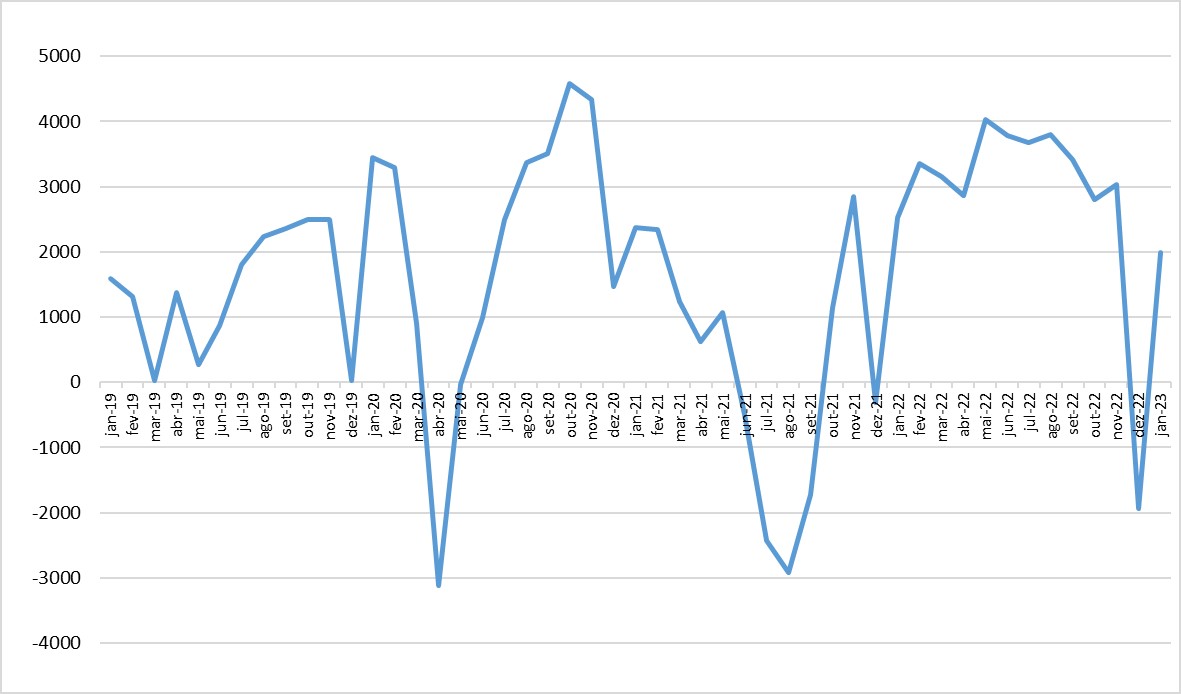
Source: OBMigra (2023), based on data from the harmonized database RAIS-CTPS-CAGED and the Digital System of Tax, Social Security and Labor Obligations (eSocial).
GRAPH 13
Movements of migrant workers in the formal labor market, by sex and main countries - Brazil, October 2022.
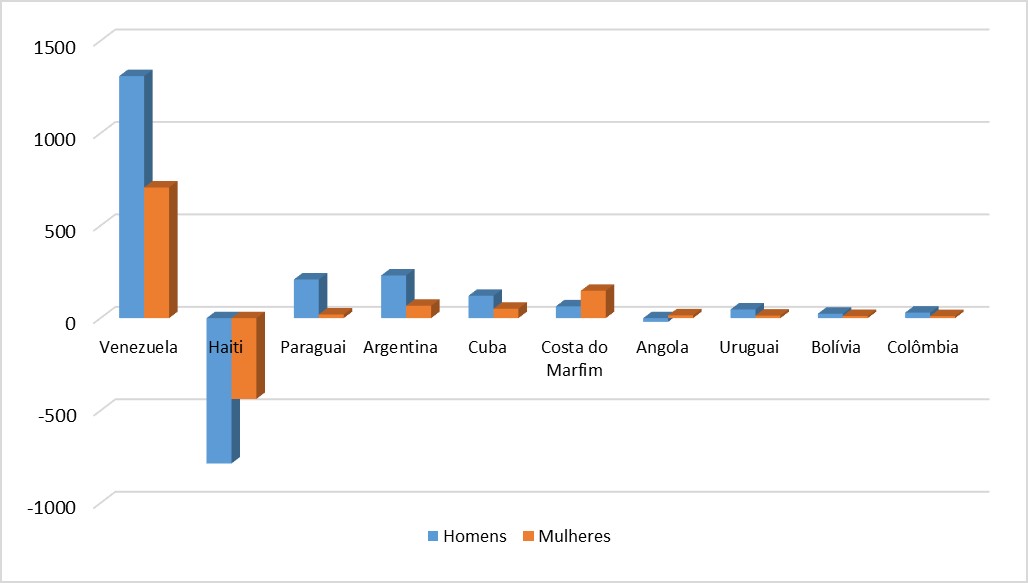
Source: OBMigra (October 2022), based on data from the Ministry of Economy, Harmonized database RAIS-CTPS-CAGED.
MAP 4
Number of jobs created for immigrants, acoording to Regions, January 2023.
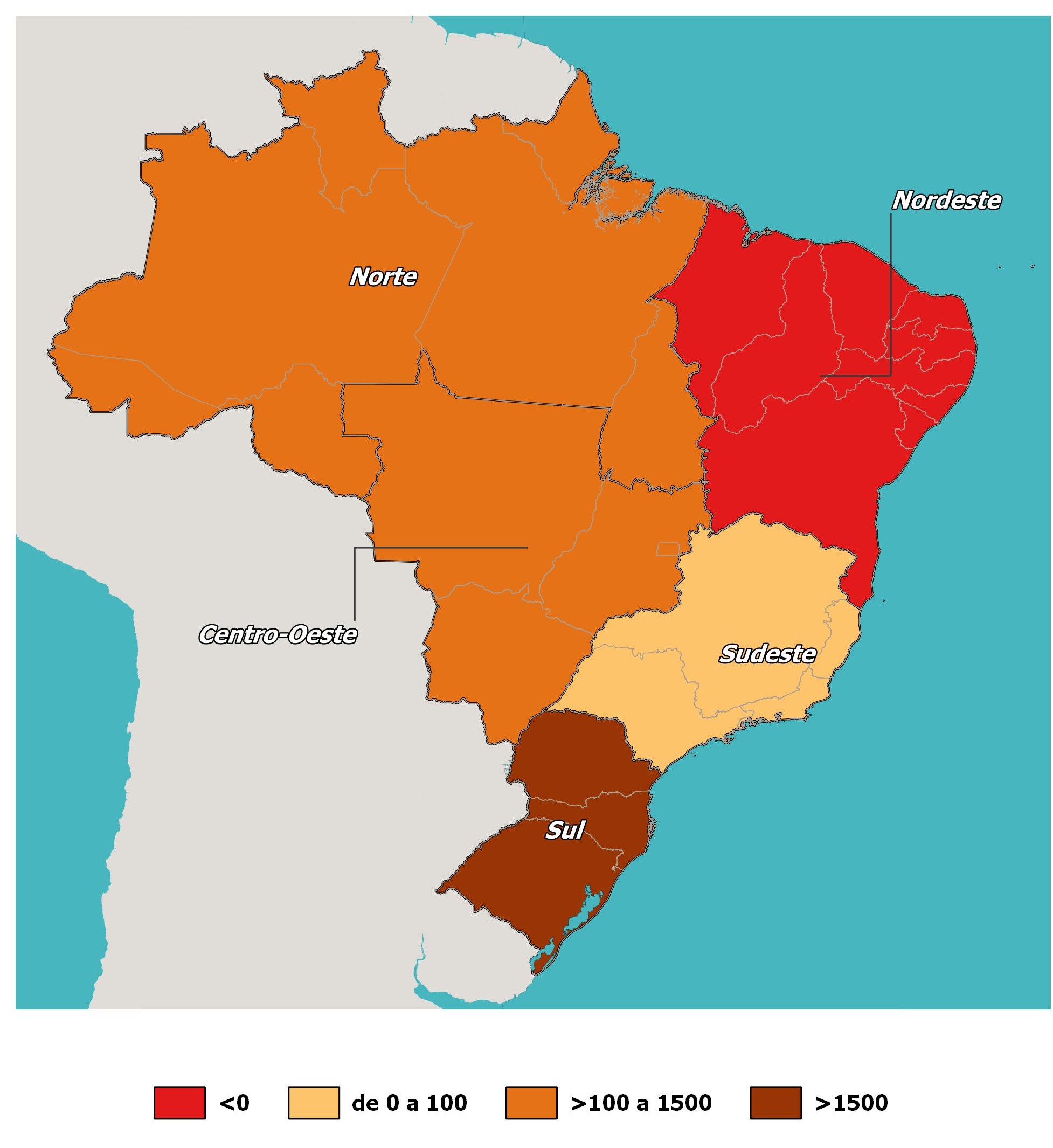
Source: OBMigra (October 2022), based on data from the Ministry of Economy, Harmonized database RAIS-CTPS-CAGED.
BACEN - Transferências Pessoais
BACEN - Personal Bank Transfer
For the first time, the OBMigra Monthly Report includes data on bank transfers from and to Brazil via personal accounts. These public data are provided by the Statistics Department of the Central Bank of Brazil and are now being disseminated by OBMigra as well.
Since January 2019, bank transfer balances have been favorable to Brazil, demonstrating a growth trend accompanied by some fluctuations throughout the historical series. This trend continued until June 2022, when it began a downward trajectory, although still remaining at positive levels (Graph 14).
When analyzing capital flows, it is evident that the resources entering Brazil originate from countries that are the primary destinations for our emigrants, mostly located in the Global North, with the exception of Angola. The largest amounts of resources came from the United States of America, Portugal, and the United Kingdom (Map 5).
In the opposite direction, besides the US and Portugal being the main recipients of foreign exchange, countries such as Bolivia, Haiti, Peru, and China are also observed among the major recipients (Map 6).
GRAPH 14
Balance of transfers via personal accounts in US$ (millions), by month of remittance - Brazil, 2019/2023
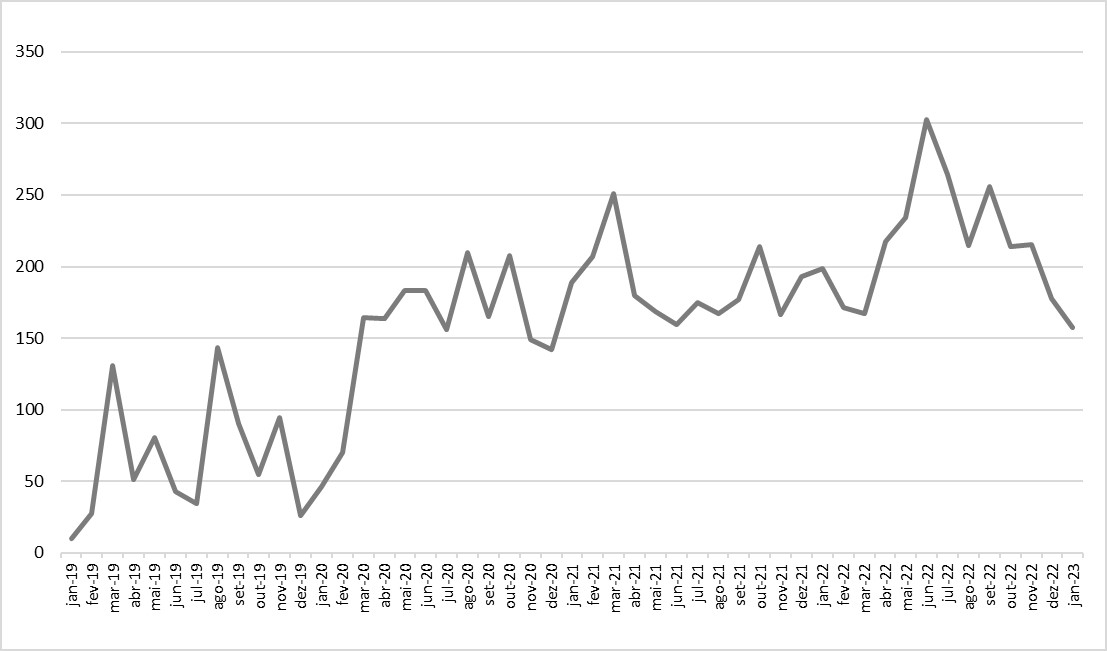
Source: OBMigra (2023), based on data from the Central of Bank of Brazil, Department of Statistics.
MAP 5
Transfers via personal accounts in US$ (millions), by revenue and by main countries - Brazil, January 2023.
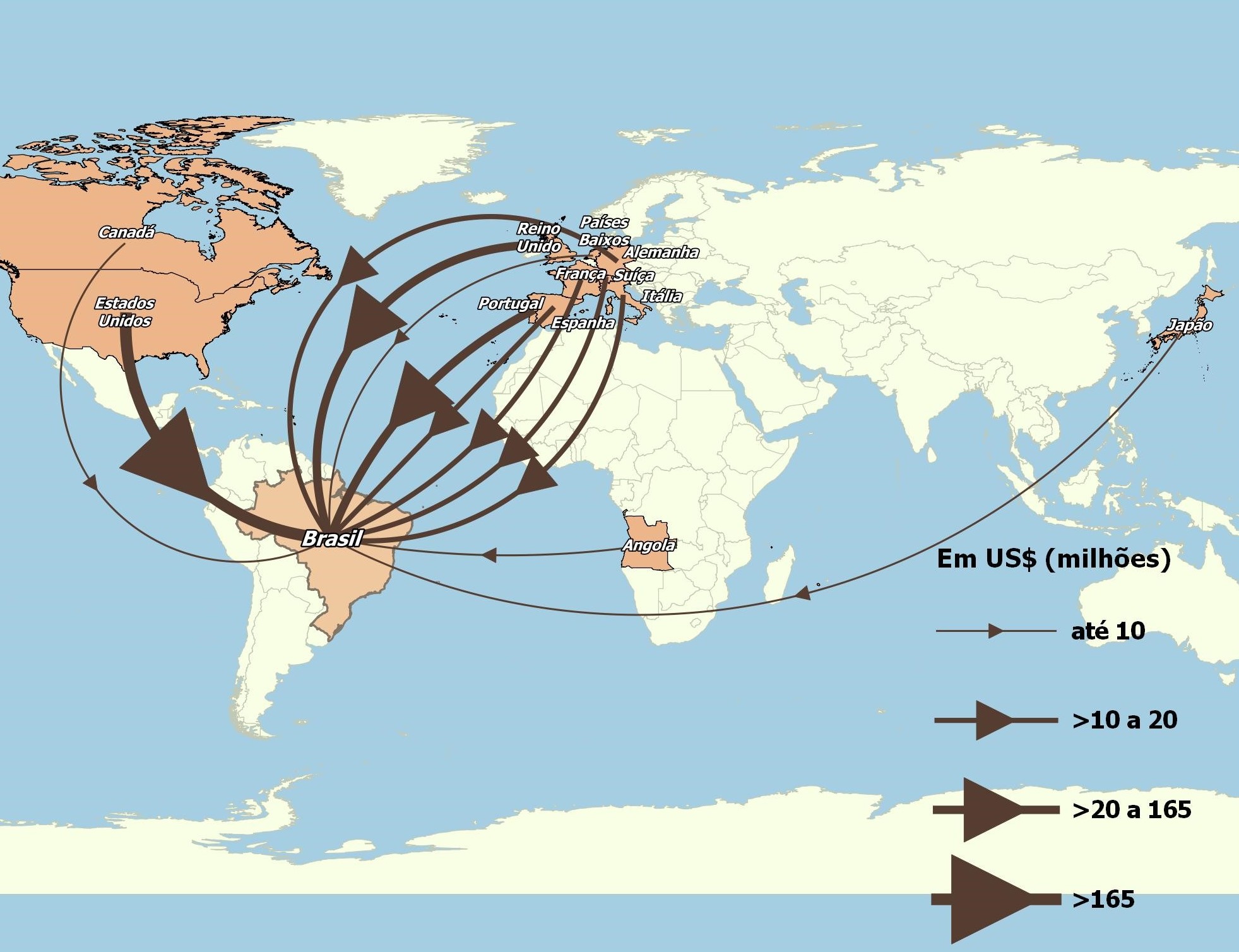
Source: OBMigra (to January 2023), based on data from the Central of Bank of Brazil, Department of Statistics.
MAP 6
Transfers via personal accounts in US$ (millions), by expanse and by main countries - Brazil, January 2023.

Source: OBMigra (to January 2023), based on data from the Central of Bank of Brazil, Department of Statistics.
COMO CITAR
The reproduction of this text and the data contained therein is permitted, provided that proper citation of the source is included. Reproduction for commercial use is prohibited.
How to cite this text:
|
CAVALCANTI, L; OLIVEIRA, T; FURTADO, A; DICK, P; QUINTINO, F; SILVA, B. Acompanhamento de fluxo e empregabilidade dos imigrantes no Brasil: Relatório Mensal do OBMigra Ano 4, Número 2, fevereiro de 2023/ Observatório das Migrações Internacionais; Brasília, DF: OBMigra, 2023. Available at: https://portaldeimigracao.mj.gov.br/pt/dados/relatorios-mensais
|




















